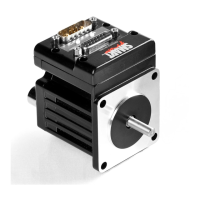Moog Animatics SmartMotor™ Developer's Guide,Rev. L
Page 128 of 909
WARNING: The MTB feature only works when power is applied to the
SmartMotor. Therefore, DONOT use it as a substitute for a physical brake
when operator or equipment safety is an issue.
The MTB command immediately activates dynamic braking independently of the Brake mode.
Issuing MTB while the motor is running turns off the motor drive and enables dynamic
braking, even if BRKRLS has been issued. To remove the effect of the MTB command, either
issue a BRKRLS OFF command sequence or issue a motion command.
BRKENG can engage dynamic braking unconditionally as well. The opposite of this command is
BRKRLS; OFF will not remove the effect of BRKENG.
To allow a motor to freewheel, issue OFF. To ensure that the MTB command is not active,
command BRKRLS and the dynamic braking will release. Finally, because faults can also
activate dynamic braking, clear the faults or choose a fault action of freewheel.
Status Word 6, Bit 11 reports if dynamic braking is active or not, including as a result of the
MTB command, the BRKENG command or a fault action.
Index Capture Commands
The SmartMotor's encoder capture mechanism has many capabilities. Both the internal and
external encoders can be triggered by certain events to capture their positions.
For a capture to occur, one of the arming commands must be issued (see the following list).
These commands allow you to select a rising or falling edge of the source event and specify
the encoder to be armed.
Ai(arg) Arm the rising edge only; encoder selected by arg
Aj(arg) Arm the falling edge only; encoder selected by arg
Aij(arg) Arm the rising edge, wait for that event, then arm the falling edge;
encoder selected by arg
Aji(arg) Arm the falling edge, wait for that event, then arm the rising edge;
encoder selected by arg
Arg is 0 to arm the event currently assigned to the internal encoder; arg is 1 to arm the event
currently assigned to the external encoder.
Status Word 1 contains bits (Bi, Bj, etc.) that indicate when a particular arming sequence is
active and when the capture has taken place. For details, see Motor Index/Capture Directly-
Addressed Status Bits on page 210. Also, see Status Word: 1Index Registration and
Software Travel Limits on page 880.
After the capture has occurred, the corresponding rising or falling edge can be read using the
commands I(arg) and J(arg), respectively. That allows the rising and falling edges to be
recorded separately. Again, arg is 0 for the internal encoder’s position at the time of the
event; arg is 1 for the external encoder’s position at the time of the event.
Part 1: Programming: Index Capture Commands

